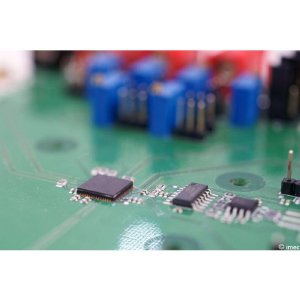Imec and Holst Centre have recently presented an ultralow-power 2.4GHz/915MHz receiver with good sensitivity. The receiver runs on a record low power consumption: it only needs 51µW when continuously on.
It occupies 0.36mm2 in 90nm CMOS, and for 10kb/s on-off keying (OOK) reception it achieves -69dBm and -80dBm sensitivity at 2.4GHz and 915MHz respectively.
 Test PCB with imec and Holst Centre’s wake-up receiver IC.
Test PCB with imec and Holst Centre’s wake-up receiver IC.
The novel receiver can be used in one of two ways: as a wake-up receiver, or as an ultralow-power component in a very asymmetric radio link.
When used as a wake-up receiver, it monitors the communication channel and wakes up the main receiver when it is needed. Today’s battery-operated wireless communication systems - think of WiFi or Bluetooth - consume a lot of power even at times when there are no data to transmit or receive. A first step to reduce the power budget of these radios is through duty cycling: activating the radio at regular intervals, and deactivating it in between. But this is still a sub-optimal schema; the radio will still be active when there are no data to receive or transmit. Adding a wake-up receiver such as this one allows keeping the main receiver inactive when it is not needed.
A second use is as an ultralow-power receiver in an asymmetric radio link, where one side is a highly-sensitive transceiver, and the other side an ultralow-power node. An example use is in smart buildings, where you could tag construction elements with cheap, low-power wireless sensors driven by energy harvesters. Other uses are in long-range radio-frequency identification (RFID), wireless sensor nodes for logistics, smart buildings, automotive, healthcare etc. In this scenario, the ultralow-power receiver can be further duty-cycled, bringing its power budget down to a level that can be handled with energy harvesters.
For truly autonomous sensor nodes, using energy scavenging, there is only around 50µW power available for a receiver. Receivers with such low power budgets normally make use of an envelope detector. However, such a detector will attenuate low-level input signal and add excessive noise, making the wake-up receiver less sensitive.
Imec and Holst Centre’s work has focused on achieving an improved sensitivity using an envelope detector. A first technique is to amplify the signal before the detector, improving the signal-to-noise ratio. Next, a double sampling technique is applied to the downconverting envelope detector to suppress the offset and 1/f noise. This not only improves the sensitivity, but also flattens the output noise floor of the receiver. By reducing the data rate and narrowing down the output bandwidth, the receiver sensitivity is improved accordingly. This is a major advantage for the wake-up receiver, since it doesn’t require a high data-rate.
The new receiver chip was implemented in a 90nm digital CMOS technology and occupies an area of 0.36mm². Measurements on Si show a sensitivity of -75dBm (SNR>12dB) for the 915MHz receiver at 100kbps OOK modulation. When scaling the data rate to 10kbps and filtering the out-of-band noise, the sensitivity is improved by 5dB. For the 2.4GHz receiver, the sensitivity is -64dBm and -69dBm for 100kbps and 10kbps data rate respectively.
For more information contact:
• Guido Dolmans, [email protected], program manager
• Olivier Rousseaux, [email protected], business development manager